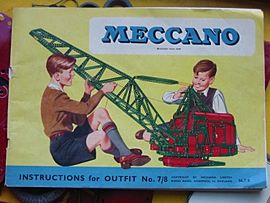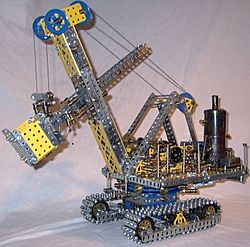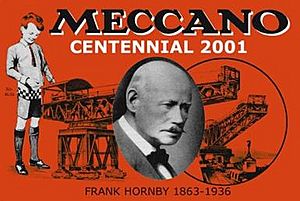Meccano facts for kids
Meccano is a fun and educational building toy. It uses reusable metal strips, plates, and girders, along with wheels, axles, and gears. You connect these pieces using nuts and bolts. It's a super versatile toy that lets you build all sorts of working models and cool mechanical devices!
Meccano was invented in 1901 in England by Frank Hornby. The British company, Meccano Ltd, made it from 1908 to 1980. Today, Meccano is made in France and China.
Contents
Meccano's Story
How Meccano Started
In 1901, Frank Hornby, who was a clerk from Liverpool, England, came up with a new toy. He called it "Mechanics Made Easy." This toy was based on how real machines work. It was a building kit with metal strips, plates, and girders that had holes in them. It also had wheels, pulleys, gears, and axles for movement. You used nuts and bolts to connect everything. The holes were always ½ inch (12.7 mm) apart.
The only tools you needed were a screwdriver and spanners. It was more than just a toy; it taught you about basic mechanical ideas like levers and gears.
At first, other companies made the parts for Hornby. But soon, so many people wanted the toy that Hornby opened his own factory in Liverpool. The building kits became very popular and were soon known as Meccano. They were sold all over the world! In 1907, Hornby officially registered the Meccano trademark. In 1908, he started Meccano Ltd.
To keep up with demand, a new Meccano factory was built in Liverpool in 1914. This factory was Meccano Ltd's main office for 60 years. Hornby also opened Meccano factories in France, Spain, and Argentina. The name "Meccano" might have come from the words "Make and Know."
The first Meccano sets weren't perfect. The metal parts were thin and not very strong. But manufacturing got better, and by 1907, the quality improved a lot. The metal strips were made of thicker steel and were nickel-plated. The wheels and gears were made from brass.
The first sets under the Meccano name were numbered 1 to 6. In 1922, the No. 7 Meccano Outfit came out. It was the biggest set then and very popular because you could build so many models with it.
In 1926, to celebrate 25 years of his invention, Hornby introduced "Meccano in Colours." This is when the famous red and green Meccano pieces first appeared. Later, in 1934, the colors changed again to gold strips and blue plates with gold lines. These gold and blue sets were only sold in Great Britain until after World War II in 1945. The red and green sets were still made for other countries and came back to Great Britain after the war.
Meccano's Golden Age

In 1934, the nine main Meccano sets (numbered 00 to 7) were replaced by eleven new sets (0, A to H, K, and L). The old No. 7 set became the L Outfit. Many people think the L Outfit was the best of the large Meccano sets.
In 1937, the lettered sets were replaced by numbered sets, from 0 to 10. The L Outfit was replaced by the No. 10 Outfit. Even though it was a bit smaller than the L Outfit, the No. 10 Outfit became Meccano's most important set. It stayed pretty much the same until it was stopped in 1992. You could also buy accessory sets to upgrade your current set to the next size. Meccano Ltd also sold individual parts if you needed them.
World War II stopped Meccano production in England. The factory made things for the war effort instead. The Korean War in 1950 also caused problems because metal was hard to get. It wasn't until the mid-1950s that Meccano production went back to normal. New parts were added to all the sets then.
New Owners and Changes
In the early 1960s, Meccano Ltd started having money problems. Lines Bros Ltd (Tri-ang) bought the company in 1964. To give Meccano a fresh look, the colors changed again. This time, plates were yellow and black, and strips were silver. The silver parts scratched easily, so they were changed to zinc in 1967. Yellow and black were chosen because they were common colors for large construction vehicles.
In 1970, electronic parts were added for the first time. The black plates changed to blue. The number of sets was also reduced. The No. 10 set stayed the same.
Lines Brothers went out of business in 1971. Airfix Industries bought Meccano Ltd in 1972. In 1978, the Meccano sets were changed again. New sets, labeled A and 1 to 5, replaced the old No. 2 to 8 sets. The No. 9 and 10 sets stayed mostly the same. By 1980, Airfix also had money problems. They closed the factory in England, ending Meccano production there. However, Meccano was still made in France.
Meccano Today
In 1981, General Mills, a toy company from the United States, bought what was left of Meccano UK. This gave them full control of Meccano. All the old Meccano sets were stopped. A brand new line of sets called "Meccano Junior" was made in France. These new sets had many plastic parts and could only build small models. This meant Meccano's idea of "Engineering in Miniature" was mostly lost, and it became more of a simple toy.
In 1985, General Mills sold Meccano to a French accountant named Marc Rebibo. Again, all the existing Meccano sets were stopped. The "Meccano Junior" sets were replaced with "Premier Meccano" sets. Older Meccano sets (No. 5 to 10 from 1981) were brought back because people wanted them.
In 1989, Marc Rebibo sold Meccano to Francois Duvauchelle. New bolts were used, and the "Plastic Meccano Junior" sets returned. To appeal to younger builders, many themed sets were introduced. These included "Construction and Agricultural" sets, "Space" models, and "Dynamic" sets. The older-style No. 5 to 10 sets were made until 1992.
In 1994, more themed sets came out. In 1996, "Action Control" sets with infrared controls were added. In 1999, the "Motion System" range of sets changed how Meccano looked completely. These sets had their own unique color schemes.
In 2000, Nikko, a Japanese toy company, bought Meccano. They launched new sets like "Crazy Inventors" and "Future Master." Nikko still makes Meccano in France and China today.
Modern Meccano is quite different from the older sets made in the 1930s to 1950s. Some long-time fans prefer the older versions. Today's Meccano often has thinner plates or plastic parts. The bolts are different, and new specialized pieces have been added. However, some things have stayed the same, like the ½ inch hole spacing and the 5/32 inch nut and bolt threads.
What You Can Build

With a Meccano set, you can build a huge variety of models. For example, the largest set from the late 1950s, the "Outfit 10," came with instructions for models like:
- "Railway Service Crane"
- "Sports Motor Car"
- "Coal Tipper"
- "Cargo Ship"
- "Double Decker Bus"
- "Lifting Shovel"
- "Blocksetting Crane"
- "Beam Bridge"
- "Dumper Truck"
- "Automatic Gantry Crane"
- "Automatic Snow Loader"
- "4-4-0 Passenger Locomotive"
You could also get extra instruction leaflets for even more models, like a "Combine Harvester" or "The Eiffel Tower."
Today, Meccano fans like G. Maurice Morris and MW Models create their own model plans. These can range from small models to huge, complex machines that are much bigger than any single Meccano set.
Meccano is a very flexible building system. You can build almost any mechanical device with it, from working cranes to automatic gearboxes. You can even use it to test new ideas and inventions! What you can build with Meccano is only limited by your imagination.
In 2002 and 2005, Tim Robinson built working Meccano models of Charles Babbage's amazing Difference Engines.
The biggest Meccano model ever built was a giant Ferris wheel. Meccano S.A. in France made it in 1990. It was a copy of the original 1893 Ferris wheel built by George Ferris in Chicago. This huge model was sent to the United States to promote "Erector Meccano." It was displayed in New York City and later bought by Ripley's Believe It or Not! for their museum in St. Augustine, Florida. This amazing model is 6.5 meters (21.3 feet) tall. It weighs 544 kilograms (1,200 pounds) and was made from 19,507 pieces and 50,560 nuts and bolts! It took 1,239 hours to build.
Meccano's Popularity

By the late 1920s, Meccano was known all over the world. Meccano clubs started forming, and in 1930, Frank Hornby created the Meccano Guild to bring these clubs together. In 1989, The International Society of Meccanomen was started in England. It has about 600 members in over 30 countries!
There were also magazines and special leaflets about Meccano. The Meccano Magazine was published from 1916 to 1981. These publications showed how to build very large and complex models, sometimes called Meccano Super Models. These big models were often shown at exhibitions and in stores.
Even today, more than a hundred years after it was invented, thousands of Meccano fans exist worldwide. There are hundreds of websites about Meccano's history, how to build models, and old memories. People and companies still make copies of various Meccano parts, even ones that are no longer produced. Every year around July, there's a World Meccano Exhibition in Skegness, England. Meccano is one of the few products that has been successful for so long!
Many people today remember building with Meccano when they were kids. For some, playing with Meccano even helped them choose their future careers.
Images for kids
-
An early Meccano set on display in the Edinburgh Museum of Childhood
-
MOTAT's Meccano differential analyser in use at the Cambridge University Mathematics Laboratory, around 1937. The person on the right is Dr. Maurice Wilkes.
-
A Liver bird sculpture that looks like it's made from Meccano. It's at Liverpool Shopping Park, where the old Meccano factory used to be.
See also
 In Spanish: Meccano para niños
In Spanish: Meccano para niños











